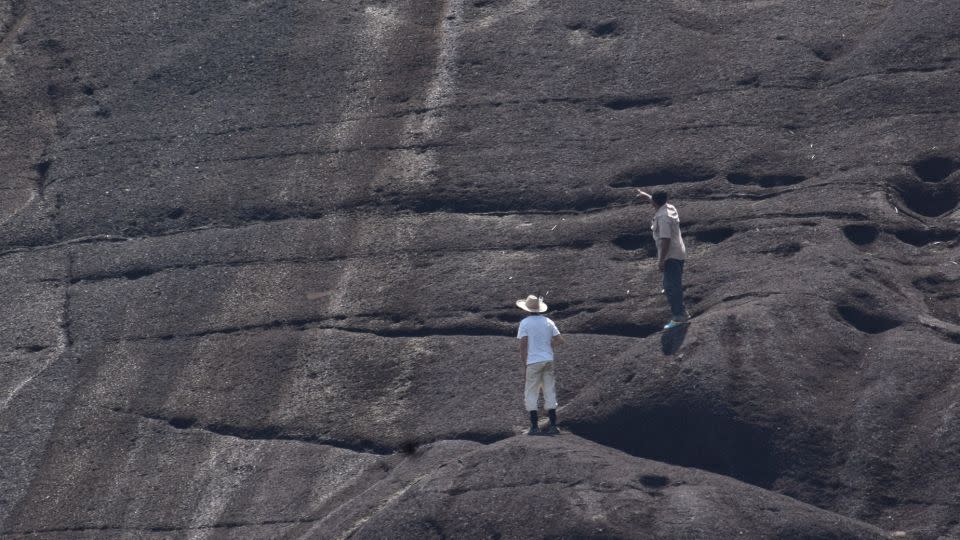Sign up for CNN’s Wonder Theory science newsletter. Explore the universe with news about fascinating discoveries, scientific breakthroughs and more.
Ancient rock carvings in what is now South America – believed to be among the largest in the world – were intended to mark the boundaries of territories inhabited by their creators, according to a new study.
Birds, Amazon centipedes, human figures and geometric shapes are among the drawings, found in 14 locations – most already known, but some recently discovered – along a 97-kilometer stretch of the Orinoco River, in present-day Venezuela. and Colombia.
However, the most represented reason is gigantic snakesand one in particular – at a site called Cerro Pintado, in Venezuela – at around 42 meters long is probably the largest rock carving recorded anywhere in the world, the researchers suggested.
“There are two sides to these territorial markers,” said Dr. Philip Riris, lead author of the to study published Monday in Antiquity magazine. “One could be a warning sign: you’re in our backyard, you better behave. The other could be an identity marker – you are in our backyard, among friends. But I don’t think they had a single purpose, so they could easily be both.”
Snake mythology
The study focuses on the meaning and role played by snakes in the mythology of the region’s indigenous people, said Riris, senior lecturer in archaeological environmental modeling at Bournemouth University in the United Kingdom. He believes locals likely carved the rocks between 1,000 and 2,000 years ago, based on pottery and motifs from that time found in the same area.
“Snakes are really interesting because they are nurturers and protectors. According to local mythology, they shaped the rivers as they traveled, but they are also predators, full of dangerous energies that you need to respect to not fall into conflict with their wrath,” said Riris, explaining why they could also have a double meaning. like rock carvings.
All of the snake drawings share a visual consistency, and Riris believes they could represent boas or anacondas, although the artists weren’t necessarily interested in accurately representing certain species: “Indigenous people don’t always distinguish between species in the same way that we do.” . do in scientific taxonomy – they could just be large, predatory snakes that kill by constriction,” he said.
Human figures are often depicted alongside snakes, as are giant Amazonian centipedes, which are predators of snakes in the Orinoco. The geometric designs include concentric circles, spirals and rectangles, but their meaning is not very clear, according to Riris.
The use of ancient monumental markings as territorial markers has been noted before, but the Orinoco engravings stand out, Riris noted.
“What makes the Orinoco special is its size, the sheer quantity and density, and the effort its breeders had to go through to produce them,” he said. Some of the rock formations they are carved into are “dangerous,” Riris added, noting that artists may have had to use ropes or ladders to reach them.

Indigenous guardians
The study is the result of data collected during 10 years of fieldwork by Riris and his colleagues – co-authors Dr. José Oliver and Natalia Lozada Mendieta – although some of the research has been used for other studies. Oliver is reader in Latin American archeology at University College London and Lozada Mendieta is assistant professor of art history at Universidad de Los Andes, Colombia.
The markers are located on a section of the river called Atures Rapids, known to have been an important trade and travel route in prehistoric times. The team used special software to recreate the point of view of previous residents and visualize what the markings would have looked like to them.
Today, with the rapid growth of tourism, the sites may be at risk of vandalism, and researchers have registered them with Colombian and Venezuelan national heritage bodies.
“Fortunately, as far as we know, none of them were damaged, but with more people around, they are more exposed,” said Riris, adding that both authorities and indigenous people, who feel a sense of ownership over them, need to be involved. in its safeguarding.


The ancient works give us a rare glimpse into how native Orinoco groups perceived their landscape and made it sacred and instrumental through rock carvings, said George Lau, professor of art and archeology of the Americas at the University of East Anglia in the United Kingdom. . . He was not involved in the study.
“It also shows the long-term resilience of this art to native landscapes, especially the importance of mythical creatures to local belief systems. The study is really just the tip of the iceberg of this region’s enormous archaeological wealth and ancient cultures,” he added.
Alexander Geurds, associate professor of Central and South American archeology at the University of Oxford in the United Kingdom, said this research is a fundamental contribution to the understanding of rock art in northern South America. He was also not involved with the work.
The study goes beyond previous work, Geurds said, because it doesn’t simply record the location and style of the sculpted representations, but also deals with their extraordinary size. Applying computer-based visual analysis is an innovative step, he added, as it helps understand how the scale of the sculpture relates to the possibility of seeing them from afar – a likely scenario if indigenous groups traveled along the Orinoco River.
Part of the fundamental importance of these large-scale sculptures is the collective work they required: “Especially on rivers and larger river junctions, these could have been places where people gathered to forge intercommunal bonds during late pre-Hispanic times,” said Geurds. . . “Additionally, the rapids are (ironically) where canoe traffic slows down, allowing for adequate theater for viewing the images. These monumental snakes are silent witnesses of this past social world.”
For more news and newsletters from CNN, create an account at CNN.com






























